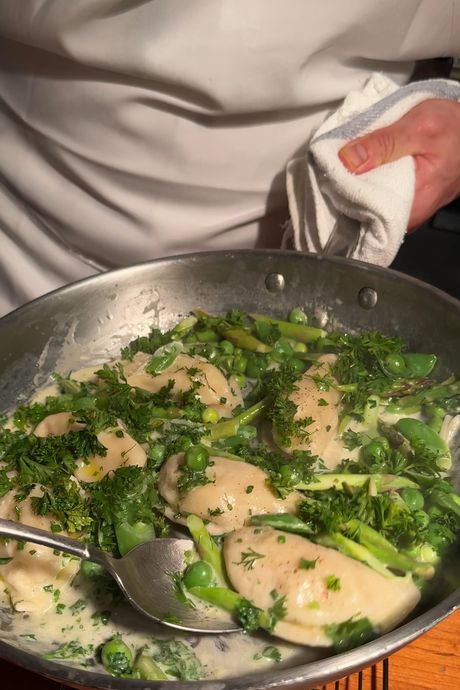Long ago, the Fedorables, as they were known, gathered at 239 West 4th Street, under a neon sign saluting their patroness, for red-sauce prix fixe on the tables and Wheel of Fortune on the TV. Fedora, which opened in 1952, remained for nearly 60 years an unspoiled, if overripening, institution, christened not — as it would be easy to imagine — for the hat but for its owner, Fedora Dorato, one of three Florentine sisters named for opera heroines. (Fedora, in Umberto Giordano’s opera of 1898, is a Russian princess out to avenge her lover’s murder.) The Fedorables seem to have been girls in the camp, pre-Stonewall sense — much of the restaurant’s early success was credited to the efforts of Burke McHugh, a local male model who organized a publicity campaign and later was the brains behind the revue Greenwich Village, U.S.A. — who, according to a later news item, placed quarter bets on the color of Vanna White’s dress.
These days, Greenwich Village U.S.A. is a metonym of the good boho life. Today’s Fedorables are West Village Girls, and while the style has changed, they still buzz toward Fedora’s neon sign, indistinguishable except in color. While Fedora Dorato and her husband, Harry, who tended the bar are gone, Fedora, now in its third incarnation, lives on.
It’s easy to see why successive restaurateurs have kept it going. Despite a basement space, Fedora is in a prime location, in a 1910 building, with one of the most iconic neon signs north of the Odeon and south of NBC. Dorato once claimed that Graydon Carter and his Waverly Inn partners originally wanted it; Gabriel Stulman, whose local empire included Joseph Leonard and Jeffrey’s Grocery, eventually got it. That Fedora (nose-to-tail cooking, beginning in 2011) had its day and closed during the pandemic. Now, the group that runs St. Jardim, a wine bar in Stulman’s old Bar Sardine space on the corner, takes its turn.
The West Village Girls have followed. I’d only been at the new Fedora an hour when in bounced a latter-day Carrie Bradshaw, with giant blonde curls and wearing a spaghetti-strap slip dress, who slid into a corner table of couples sipping cocktails in little coupes. The room has maximized its vibes, reflecting warm-pink light off its irreplaceably low ceiling, bathing the place in a flattering, rose-glasses glow. The bartender, meanwhile, spins vintage records on a small turntable (the Brazilian singer Jorge Ben the night I was there).
These are fertile conditions for a first date, maybe even better for a lingering third, and Fedora makes the most of them. Its menu, by the former Le Rock chef Monty Forrest, is compact but often quite good, and its wine list, from St. Jardim’s Basile Al Mileik, a Four Horsemen alum, is excellent and, even rarer, largely affordable.
What Fedora is not, though, is particularly coherent. Its sensibility seems to be, for lack of a better term, Pan-European. There’s a rotation of Italian salumi to begin — some nights, the unusual but delicious spalla, from the pork shoulder, thickly ribboned with fat; other nights coppa — served with, anise-scented taralli. That, and the menu’s single pasta, an appealing appetizer portion of bread-crumbed spaghetti with clam broth, would lead you to Italy. Tilefish with bourride, here recast as a kind of seafood-y aïoli, and black bass Provençal, are from the south of France. The house martinis, made with Mahón gin and sherry vermouth, are Spanish. No one really knows where chicken cordon bleu comes from, but here it is, a breaded-and-fried missile oozing cheese and a thin slice of Black Forest ham.

Chicken cordon bleu; pierogi with alliums and peas. Hugo Yu.
Chicken cordon bleu; pierogi with alliums and peas. Hugo Yu.
I do admire that Fedora isn’t taking the low-ambition way out. There’s no burger here, no half-chicken, no steak-frites. Instead, there’s a few slices of beef culotte, served, in a sort of English-manor-house style, with a few bare carrots and so lavishly capped with fat that two of my companions blanched. (I loved it.)
Consistency in theme is an overrated virtue, but consistency in quality isn’t. For every great dish, there was one that needed more tinkering: chewy rings of squid with sunny-side-up quail eggs, the tough torpedo of cordon bleu. A few visits didn’t give me any reliable sense even how to predict what would work and what was likely not to. Get the pierogi with a spring mix of green peas and beans if you see them and the spicy, unexpectedly delicious homemade merguez if it’s still there, too.
I wouldn’t be surprised if, in time, the restaurant settles into a steadier groove. I hope it does. It has charm to recommend it and an adoring public — the WVGs with wide-legged pants and tiny rattan bags holding court in the cramped corner of the bar, alternating between their phones and their cocktails — looking for a new spot to sip and meet cute. Imagine the opening number to a freshly revised Greenwich Village, U.S.A.: “Our eyes met over merguez …” Kind of has a ring to it, no?
Good Wine
Many of the bottles are under $100, and a few, hovering around there, are not too marked up for the retail price.
The Better Bathroom
One of the restrooms is in the front corner, among its busiest bar spots. Use the one in the back.
Not Too Sweet
Fedora doesn’t have a dedicated pastry chef, but my favorite dessert was the grissini-length pistachio biscotti.
See All
